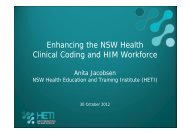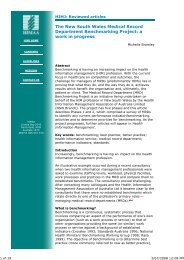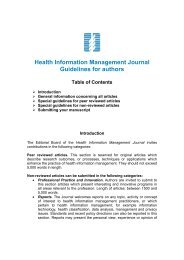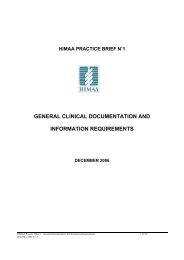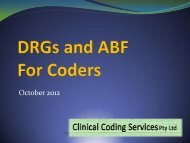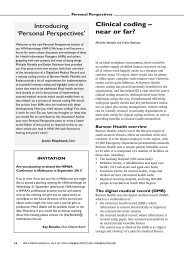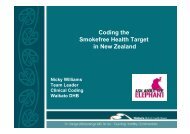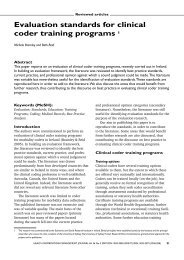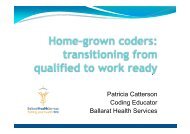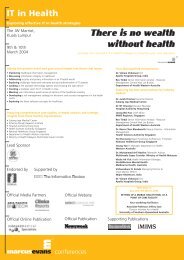A framework for evaluating health classifications - Health Information ...
A framework for evaluating health classifications - Health Information ...
A framework for evaluating health classifications - Health Information ...
You also want an ePaper? Increase the reach of your titles
YUMPU automatically turns print PDFs into web optimized ePapers that Google loves.
Reviewed Articles<br />
liamson (2001) reviewed NSW injury data from 1995-<br />
1999 and found that residual categories were overrepresented<br />
in the data set. They could not determine<br />
whether this was because of poor source in<strong>for</strong>mation or<br />
inadequacies of the ICD’s theoretical <strong>framework</strong><br />
(p.103).<br />
Be<strong>for</strong>e any more specificity is added to this chapter,<br />
research needs to be undertaken to determine whether<br />
there is enough detail in the source in<strong>for</strong>mation to satisfy<br />
the specificity. Only then will we know if these<br />
changes have indeed led to ‘some major gaps in [injury]<br />
in<strong>for</strong>mation … being filled’ (Harrison 2001).<br />
4.5 Compatibility/comparability<br />
A <strong>health</strong> classification should be compatible or comparable<br />
with other similar <strong>health</strong> <strong>classifications</strong> in use,<br />
both nationally and internationally.<br />
Example 4.5<br />
Recall that mapping is a mechanism used <strong>for</strong> maintenance<br />
of a <strong>health</strong> classification. Mapping also measures<br />
comparability between <strong>health</strong> <strong>classifications</strong>. Mappings<br />
between different <strong>health</strong> <strong>classifications</strong> can demonstrate<br />
the quality of the relationship through the number of oneto-one<br />
mappings, representing minimal loss of detail.<br />
However, the quality of the relationship will always be<br />
dependent on the purpose of the mapping.<br />
ICPC-2 is mapped to the ICD-10 to demonstrate the compatibility,<br />
and facilitate linkage, between the two <strong>classifications</strong><br />
(Lamberts & Wood 2002; Okkes et al. 2002;<br />
Wood et al. 1992). The mappings are useful <strong>for</strong> conversion<br />
of data from ICPC-2 to ICD-10 and vice versa (Britt,<br />
Beaton & Miller 1995), and thus provide a connection or<br />
common language between primary care services and<br />
acute care services.<br />
4.6 Subsets<br />
If a <strong>health</strong> classification serves a wide domain, then<br />
mechanisms should exist to enable the production<br />
of a subset of the classification <strong>for</strong> a specific sector<br />
within that domain, or perhaps <strong>for</strong> other domains<br />
that deem the classification suitable <strong>for</strong> their purposes.<br />
Example 4.6<br />
The Nursing Interventions Classification (Iowa Intervention<br />
Project 2000) covers all nursing domains but,<br />
because of its broad scope, may not be suitable <strong>for</strong> use<br />
by community nurses working in community-based<br />
<strong>health</strong>care settings. A subset that includes only the interventions<br />
appropriate to their domain may be less<br />
cumbersome and more useable than the larger classification.<br />
ICD-10-AM is the mandated classification <strong>for</strong> use in<br />
Australian acute and community-based mental <strong>health</strong><br />
services. In community <strong>health</strong> centres, there are limited<br />
numbers of trained coding staff, so it is more likely<br />
that clinicians will code and report the data. To support<br />
clinicians in this task, the NCCH developed the<br />
ICD-10-AM Mental <strong>Health</strong> Manual (National Centre <strong>for</strong><br />
Classification in <strong>Health</strong> 2002), a subset of the ICD-10-<br />
AM, Third Edition, as a diagnostic and coding tool. The<br />
manual is similar in theory to the DSM, however, the<br />
diagnostic criteria and other defining attributes of a<br />
disorder are based on a number of WHO publications<br />
that are all subsets of the ICD-10 (World <strong>Health</strong> Organization<br />
1992b; 1996a; 1996b; 1997). Other features<br />
distinguishing this manual from the DSM are the<br />
inclusion of mental <strong>health</strong> interventions, and diagnostic<br />
instruments to supplement the diagnostic guidelines.<br />
4.7 Adaptable to an electronic environment<br />
<strong>Health</strong> <strong>classifications</strong> should be adaptable to an electronic<br />
environment to broaden their usability (Hoffman<br />
& Chamie 1999). Database management of<br />
<strong>health</strong> <strong>classifications</strong> can streamline the production,<br />
maintenance, updating, mapping and exchange processes.<br />
Subsets can be more easily created from databases.<br />
Practical examples of <strong>evaluating</strong> <strong>health</strong><br />
<strong>classifications</strong><br />
Evaluation is per<strong>for</strong>med to determine the ‘merit, value<br />
or worth of things’ (Scriven 1991: p. 1). It is a rigorous<br />
process that employs both quantitative and qualitative<br />
research methodologies and should be<br />
per<strong>for</strong>med at all stages of an in<strong>for</strong>mation system’s life<br />
cycle: planning, development, implementation, and<br />
operation. Evaluation enables in<strong>for</strong>med decisions to<br />
be made based on scientific facts and thus is harmonious<br />
with evidence-based policy and practice in<br />
<strong>Health</strong> In<strong>for</strong>mation Management (Leys 2003; Rigby<br />
2001). <strong>Health</strong> <strong>classifications</strong> are essential components<br />
of in<strong>for</strong>mation systems. The following evaluations<br />
are all good examples of evaluation in practice.<br />
Some build on a theoretical <strong>framework</strong>, while others<br />
apply components of it. They each have different<br />
purposes and objectives.<br />
The Australian Institute of <strong>Health</strong> and Welfare<br />
(AIHW) evaluates <strong>health</strong> <strong>classifications</strong> <strong>for</strong> inclusion in<br />
the Australian Family of <strong>Health</strong> and Related Classifications.<br />
Their aim is to endorse national <strong>classifications</strong><br />
<strong>for</strong> specific purposes within particular <strong>health</strong> settings.<br />
As the Australian WHO Collaborating Centre <strong>for</strong> the<br />
Family of Classifications, the AIHW has aligned this<br />
work with the principles of the WHO’s family of international<br />
<strong>classifications</strong> and the United Nation’s family<br />
of international economic and social <strong>classifications</strong><br />
(Australian Institute of <strong>Health</strong> and Welfare 2002).<br />
The AIHW General Practice Statistics and Classification<br />
Unit recently lodged a submission <strong>for</strong> inclusion of<br />
the Anatomical, Therapeutic, Chemical classification<br />
system with Defined Daily Doses (ATC/DDD) and the<br />
relevant documents can be viewed online at:<br />
.<br />
When the decision was made to implement ICD-10<br />
in Australia, the next task was to determine the most<br />
appropriate procedure classification to be used in conjunction<br />
with the ICD-10 (Bramley 1994). Four candidates<br />
were assessed <strong>for</strong> their taxonomic quality and<br />
usability:<br />
• 3M <strong>Health</strong> In<strong>for</strong>mation Systems ICD Procedure<br />
Coding System (ICD-10-PCS) (USA);<br />
• Office of Population Censuses and Surveys Classification<br />
of Surgical Operations and Procedures,<br />
fourth revision (OPCS-4) (UK);<br />
• Commonwealth Medicare Benefits Schedule (MBS)<br />
(Australia); and<br />
<strong>Health</strong> In<strong>for</strong>mation Management 2005 ISSN 1322-4913 Vol 34 No 3 Page 79



